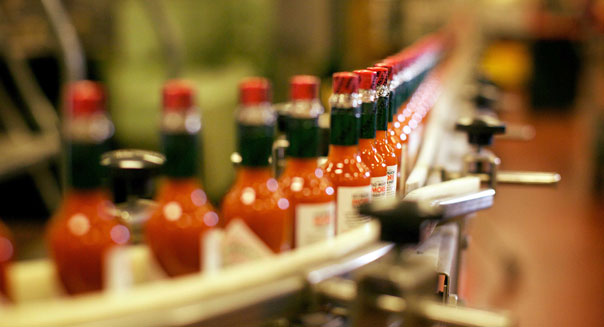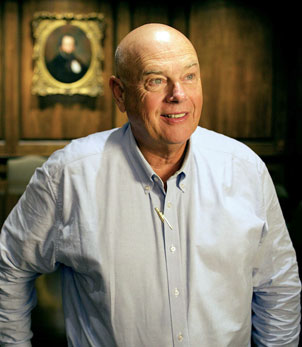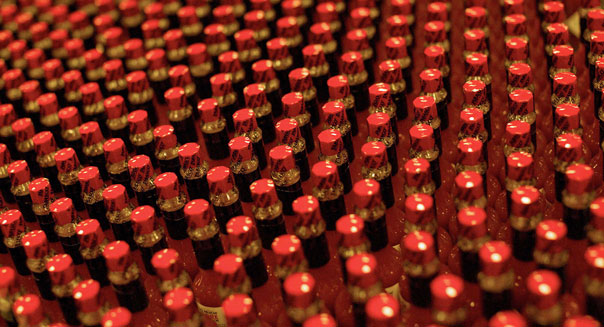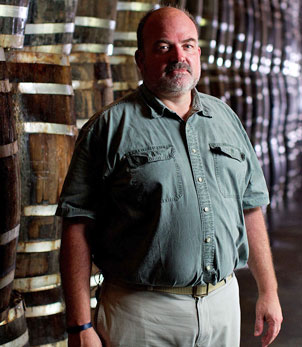Filed under: Consumer Goods, Food & Beverage, Restaurants, Entrepreneurs, This Built America

Step out of your car in front of Tabasco's manufacturing plant on Louisiana's Avery Island and the first thing you'll notice is the sweet smell of pepper in the air. It dances on the wind, tickling your nostrils and helping to clear your throat.
The island, home of Tabasco since 1868, is only a two-hour drive west of New Orleans, yet feels like another world with its lush greenery and tranquil inlets, just 14 miles from the Gulf of Mexico. And then there's the scent of those peppers that seem to draw you to the pepper sauce factory.
In the plant's mixing room, the red-orange liquid that becomes Tabasco fills wooden drums two stories high where it is stirred consistently for 28 days before bottling. Here, the sweet pepper smell takes on a more sinister incarnation. The tickle becomes a burn. Every breath you take brings a cough. You'll look around in distress and notice that while you are struggling for air, the employees tending to the tabasco seem unharmed. They walk among the vats breathing easily.
The cliched explanation for this phenomenon would be to say that the spice is in their blood. But here cliche is not far from truth. While Avery Island is the longtime home of Tabasco, it's also home to 180 people, many who are part of the company's 200-person workforce. For some, their families have lived on this island for almost as long as Tabasco has been made.

To understand the story of Tabasco, you need to understand the sauce. Read the ingredients on the bottle and the product seems overly simple, almost unimpressive. But don't let the mere three ingredients of vinegar, salt and tabasco pepper fool you. The thousands of miles and hundreds of hours that go into making one bottle is staggering
Let's start with the peppers themselves. They're grown from heritage seeds that share the same genetics as that first pepper plant grown beside a chicken coop on Avery Island around the time of the Civil War. The seeds have never been genetically altered and are so precious that a sample of them are under lock and key in a safe on Avery Island.
All tabasco peppers used for the sauce start as seedlings in the spring and must be hand-picked at precisely the right time, in the early fall, when the peppers reach that perfect shade of red. If the pepper is picked too early or too late, the taste is compromised.
Although the company would like to grow all peppers on the island, the sheer quantity they need, coupled with the plant's volatility, makes that impossible. So over the past hundred years, the company has branched out, working with 400 small farmers across the globe to help grow the plants that start from seed plants grown on the island. The tabasco plant is susceptible to all sorts of diseases, so in order to reduce the risk of losing an entire year's crop, each farm -- from South America to Africa -- only grows about two to three acres.
Once the pepper crop is picked, it's mashed at the farms and then sent back to the tabasco plant. There, it's mixed with salt from the island, which geologically is a salt dome at the edge of the Louisiana bayou and the Gulf of Mexico. The mash mixture is then placed in oak barrels and aged, like a wine or whiskey, for three years. Finally, the mash of pepper and salt is brought to the mixing room, where extra liquid is strained out, vinegar is added and the 28-day mixing process begins. After that, it's strained and bottled.
Despite some changes to the supply chain and physical plant, that's the way Tabasco has been made since Edmund McIlhenny invented the sauce in the 1860s. Five generations later, the McIlhenny Co. -- the official corporation behind Tabasco -- is still and always has been run by a direct descendant of the inventor.

Growing up in New Orleans, Simmons spent the summers on Avery Island, hiking and fishing with his cousins and employees' children. But for 25 years, Simmons worked in the heavy equipment business, living in as diverse places as Houston, Texas, Singapore, and Charlotte, North Carolina. When Simmons sold his business in the late 1990s, his cousin Paul, who was taking over as McIlhenny's chief executive officer at the time, offered him the chance to move back to Avery Island and join the family business as an executive vice president.
"The first thing that crossed my mind was whether my wife was going to be willing to agree to leave Charlotte, because we'd been there for 10 years," Simmons remembers. "But she did agree to move, to come to Avery Island to do this for my family."
In fact, it's the connection the McIlhennys have to this little slice of the Louisiana bayou that Simmons attributes to the company's stability and success. The island has been jointly owned since the early 20th century by two sides of the same family -- the McIlhennys and the Averys -- through a land corporation. The business arrangement ensures the island will always be owned by them as a whole entity.
"I think part of the reason we've been able to stay family owned and operated is because of Avery Island," Simmons says. "This sense of place, I think, has as much to do with the family's unwillingness to sell out. The two are interrelated."
Chapter 2: Yo Quiero Tabasco?
It's not uncommon to see Tabasco bottles on diner tables across the United States, but you're just as likely to find a bottle on a street cart in Taipei or in a Parisian brasserie. Or as Simmons found it, in a lodge outside of Cordoba, Argentina. There on a hunting trip, Simmons was seated next to another guest, a man from Mexico. "When he sat down, there was some Tabasco on the table," Simmons says. "And the man goes, 'Oh this is wonderful that they have Tabasco!'"
When the lodge owner told the Tabasco fan who Simmons was, the man left the table, promising to be back momentarily. When he returned, "he had a little bubble-wrapped thing in his hand," Simmons remembers. "He popped the wrap off and it was a two-ounce bottle of Tabasco! He said, 'I never go anywhere without Tabasco. It's my favorite product in the world.' "
Indeed, the spicy sauce has found a global fan base, and is sold in 186 countries. But for a brand with an iconic worldwide status, the McIlhenny Company is tiny compared to other American companies with global appeal, such as Coca-Cola and Levis.
While those brands have global advertising and operations, Simmons attributes Tabasco's success to word of mouth. In the company's vaults is a letter sent by a British soldier serving in India during the 1880s to his mother back home. In the note, the soldier tells his mother of an amazing sauce he's encountered and asks that she search for it to send to him. At that time, Tabasco was not being exported out of the United States, but Simmons says customers had started sending the sauce around the country and the world.
Simmons also believes its appeal comes from Tabasco's ability to mesh with any culture's food. "One of the nice things about the sauce is that it tends to enliven the flavor of the food, not change it," he says. Unlike other condiments like ketchup or mustard, which overwhelm or mask food flavors, Tabasco adds to it. "It works with everybody's food," he says. "That's why it's been so well-received around the world."

The McIlhennys and their peppers may have found global success, but that doesn't mean they rest on that history. Both the business, and the island that houses it, must be constantly cultivated. Today, those responsibilities are increasingly in the hands of Simmons' cousin Harold "Took" Osborn.
Born in Canada and raised in New York City and Connecticut, Osborn -- like many members of the McIlhenny clan -- spent his summers on Avery Island. The Southern lifestyle agreed with him, and after high school up North, Osborn returned to the bayou to work in the oil fields of Louisiana and attend the University of Southwestern Louisiana, just up the road from Avery Island in Lafayette.
He left for a time to explore the world, but 15 years ago returned to the island to work with his cousins. Despite his admittedly restless spirit, the vibe of Avery Island has kept him settled, "I've always loved it down here," Osborn says.
Perhaps that love of the island itself was the reason Osborn was given the job of overseeing the conservancy of this two mile-wide piece of Louisiana. "We own a lot of marshland and have done a lot of saving and protecting it," he says. "All of the channels here allow for a lot of salt water to enter the environment. The salt water comes in and scours the channels -- the marsh starts falling in and the land erodes very quickly."

Every marshland acre of the 50,000 that make up Avery Island is equally significant to Osborn -- and with good reason. "It's important to protect this island, which has really kept my family together through salt and oil and Tabasco and everything else," Osborn says, mirroring the sentiments of Simmons. "It's the feeling that the land has been good to you, so you're good to it."
But Osborn's job doesn't stop with saving the island, but also looking outside of it to keep the Tabasco brand relevant and growing globally. "I'm trying to find new ways of getting people to use the product," he says.
"A lot of people [around the world] already understand spice, so you don't have to be squeamish about showing them a product with heat," he says. Instead, Osborn is working on how people can use Tabasco differently from country to country.
Chefs are his new brand ambassadors. "We're spending a lot more time in food service and getting involved with chefs," Osborn says. "The Tabasco chef schools we put on are getting these young chefs who are just learning how to use the sauce. It helps them and it helps us. We just want people to be creative with the product."
"Like in Japan," Osborn continues. "We've never been much a part of traditional Japanese food, but the younger generation seem to be much more willing to experiment. There's a lot of food modernization or fusion that's going on. They'll take Japanese food and mix it with Mexican!"
For a man who's lived in New England, the Deep South, and a few places in between, doing many different jobs in the family company has been satisfying and grounding to Osborn. "This definitely isn't corporate America," he says. "It's a happy product and fun to be associated with. You're proud to do what you do here. It's hard to find that kind of job anywhere else."
Check out This Built America for more Made in the U.S.A. stories.